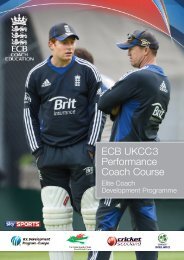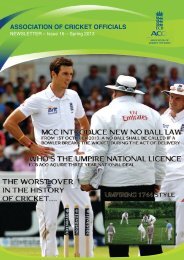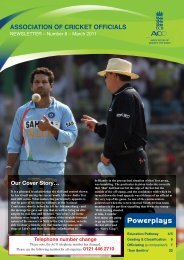STRATEGY - Ecb - England and Wales Cricket Board
STRATEGY - Ecb - England and Wales Cricket Board
STRATEGY - Ecb - England and Wales Cricket Board
- No tags were found...
Create successful ePaper yourself
Turn your PDF publications into a flip-book with our unique Google optimized e-Paper software.
NATIONAL CLUB <strong>STRATEGY</strong> 2012Foreword 01Executive summary 02Introduction to theNational Club Strategy 0401 07The current stateof club cricket02 12The challenges facingclub cricket03 17Using the strategy tobuild a sustainable futurefor club cricket04 23Support you can accessto help your club turn thestrategy into action05 30Benefits of utilisingthe strategy06 35In conclusion: the futureshape of club cricketAppendix 1 39ResearchAppendix 2 39Key PartnersAppendix 3 40ECB - History of Club DevelopmentAppendix 4 40Club StatisticsFOREWORD<strong>Cricket</strong> clubs lie at theheart of our sport. Muchof the success enjoyedon the internationalstage begins withinthe network of clubsacross <strong>Engl<strong>and</strong></strong> <strong>and</strong><strong>Wales</strong>. However, whileour clubs continue tobe the lifeblood of thenational game, theyoffer far more than justcompetitive action <strong>and</strong>are often at the heartof their communities.In countless communities, cricket clubs are vital to the social <strong>and</strong> economicfabric of the surrounding cities, towns <strong>and</strong> villages. For many lovers of thegame, the aim is not to aspire to cricket’s greatest stage, but to bring thesport’s unique values <strong>and</strong> benefits to bear in their own communities.The <strong>Engl<strong>and</strong></strong> <strong>and</strong> <strong>Wales</strong> <strong>Cricket</strong> <strong>Board</strong> (ECB) believes that a healthy networkof cricket clubs is essential to the future of the game. It has thereforeconducted a thorough review of the current state of club cricket in <strong>Engl<strong>and</strong></strong><strong>and</strong> <strong>Wales</strong>, <strong>and</strong> recognised the need to produce a sustainable plan of action.Despite the tough <strong>and</strong> uncertain economic climate in which clubs are operating,the review has found much to celebrate. In particular, there is a healthy <strong>and</strong>growing network in place to support the next generation of cricket clubpersonnel. However, we want to use this strategy to offer solutions to theremaining challenges.Our goal at the ECB is “to inspire the nation to choose cricket”. In order toachieve this we must all commit to investing our time, energy <strong>and</strong> resourcesinto club cricket. The strategy will be successful if clubs primarily focus onimproving the experiences of everyone involved in cricket. The ECB wouldlike clubs to choose to invest in grass pitches <strong>and</strong> outfields, buildings,synthetic net systems <strong>and</strong> volunteers, over <strong>and</strong> above the payment of players,which we discourage in all but the very highest levels of club cricket. Inaddition, we would like these high-level cricket clubs to question whetherpaying players is the best investment for the future of their club.I strongly encourage all bodies <strong>and</strong> individuals who have an interest in thefuture of cricket to support this strategy.We need your help, to turn this strategy into effective action.Mike Gatting OBEECB Managing Director <strong>Cricket</strong> Partnerships1
2012 NATIONAL CLUB <strong>STRATEGY</strong>NATIONAL CLUB <strong>STRATEGY</strong> 2012EXECUTIVESUMMARYDespite recordnumbers of juniorscoming into thegame, club cricketis facing a series ofsocial, economic<strong>and</strong> environmentalchallenges.2A comprehensive review of theclub game has highlighted thefollowing issues:— Inability of many clubs to make longtermplans for a sustainable future— Difficulty of recruiting <strong>and</strong> retainingadult players, members <strong>and</strong>volunteers— Lack of growth due to poor accessto, <strong>and</strong> quality of, club facilities— Growing risk to many clubs’ securityof tenure— Static or falling club income streams— Ineffective use of volunteers’ timedue to unnecessary bureaucracy— Increasing cost <strong>and</strong> time spenttravelling to <strong>and</strong> from fixtures— Damaging effects of risingtemperatures <strong>and</strong> increased rainfalldue to climate change.In response, <strong>and</strong> following widespreadconsultation, the ECB has developedthe National Club Strategy. Thisstrategy provides a framework fromwhich all ECB-affiliated clubs can planfor a sustainable future. It will remaincentral to all areas of club cricket forat least the next five years.If the ECB is to be successful in“inspiring the nation to choosecricket” then clubs must have the willto invest time, energy <strong>and</strong> resource inorder to turn this strategy into action.The ECB’s <strong>Cricket</strong> Partnerships teamis responsible for implementing thisstrategy. They will liaise closely withclubs, providing support whereit is most needed, in the four key areasof People, Places, Playing <strong>and</strong> Policy.The ECB People team will support,develop <strong>and</strong> reward those whoencourage participation <strong>and</strong> provideaccessible, affordable, high-qualitytraining <strong>and</strong> membership services.The ECB Places team will concentrateon the facilities that clubs <strong>and</strong>communities need. It will encouragecommunity partnerships <strong>and</strong> selffundedprojects, while advising onissues such as security of tenure,saving money, generating income<strong>and</strong> managing resources.The ECB Playing Team will encouragethe development of appropriate,innovative competitions. It will alsofocus on recruiting lapsed players,as well as retaining current playersby increasing the levels of satisfactionfelt by all.The ECB Policy Team will help clubs<strong>and</strong> County <strong>Board</strong>s to organise <strong>and</strong>govern themselves better <strong>and</strong> as aresult, enable clubs to gain Clubmarkaccreditation. It will also reduce thelevel of bureaucracy clubs face.All four teams will keep in closecontact with the 39 County <strong>Cricket</strong><strong>Board</strong>s (CCBs) <strong>and</strong> try to ensurethat there is no duplication ofeffort. Associated leagues, partners<strong>and</strong> other stakeholders will alsobe involved.With committed club support, webelieve that this strategy can providethe following:— Access to more <strong>and</strong> better facilities,both indoors <strong>and</strong> outdoors— Support to increase recruitment<strong>and</strong> retention of players, members<strong>and</strong> volunteers <strong>and</strong> a reduction inbureaucracy to make better useof their time— Better fixture management thatreduces unnecessary travel— Support to improve securityof tenure— Guidance on how to improvefinancial management, includingeffective fundraising, how tosave money <strong>and</strong> how to reduceoperating costs— Advice to enable clubs to planhow they will address futureenvironmental issues.A list of benefits are shown on Page 33.3
2012 NATIONAL CLUB <strong>STRATEGY</strong>NATIONAL CLUB <strong>STRATEGY</strong> 2012INTRODUCTIONTO THENATIONALCLUB<strong>STRATEGY</strong>The ECB is theNational GoverningBody (NGB) for cricketin <strong>Engl<strong>and</strong></strong> <strong>and</strong> <strong>Wales</strong><strong>and</strong> was establishedon 1st January 1997.The ECB’s role is to setpolicy, create plans ofaction, <strong>and</strong> developproducts <strong>and</strong> servicesthat enhance the game.The National Club Strategy is basedon thorough research <strong>and</strong> builds uponthe ECB’s current national strategy;Grounds to Play (2010 – 2013).AccessibilityThe ECB is committed to wideningthe game’s appeal by creating afun <strong>and</strong> safe environment, ensuringopportunities within the game areopen <strong>and</strong> accessible to all, regardlessof background. This strategy hasbeen produced in line with thatcommitment <strong>and</strong> the ECB, in all itsactivities, is fully committed to theprinciples of equality of opportunityin cricket in <strong>Engl<strong>and</strong></strong> <strong>and</strong> <strong>Wales</strong>.This strategy also demonstratesour passion to welcome as manypeople as possible into the game.clubs. The ECB expects that throughsharing knowledge, spreading bestpractice <strong>and</strong> providing accessibleresources, clubs will succeed inbuilding a sustainable future.Target AudienceThe target audience for the strategyis wide but can broadly be dividedinto the following categories:— All affiliated cricket clubsin <strong>Engl<strong>and</strong></strong> <strong>and</strong> <strong>Wales</strong>— <strong>Cricket</strong>’s internal networks includingCCBs, Leagues <strong>and</strong> the ECB— <strong>Cricket</strong>’s external stakeholders,including Sport <strong>Engl<strong>and</strong></strong>, Sport<strong>Wales</strong> <strong>and</strong> associated networks.PurposeThe purpose of this strategy is tosupport cricket clubs to take actionto meet the changing dem<strong>and</strong>s<strong>and</strong> challenges of club cricket in<strong>Engl<strong>and</strong></strong> <strong>and</strong> <strong>Wales</strong>. It is intendedthat clubs will translate the strategyinto effective action, relevant tothe specific issues facing their own45
2012 NATIONAL CLUB <strong>STRATEGY</strong>NATIONAL CLUB <strong>STRATEGY</strong> 201201 Thecurrentstateof clubcricket67
2012 NATIONAL CLUB <strong>STRATEGY</strong>NATIONAL CLUB <strong>STRATEGY</strong> 201201Thecurrentstateof clubcricket<strong>Cricket</strong>’s appeal placesit at the heart of manylocal communities,large <strong>and</strong> small.<strong>Cricket</strong> clubs act asinvaluable placesfor people to playcompetitive cricket,enjoy their leisure time<strong>and</strong> congregate withfriends <strong>and</strong> family.A cricket club is defined as abody which:— Is formed by its own members,governed by an agreed constitution<strong>and</strong>/or rules, <strong>and</strong> is initially fundedby its members (this refers toboth a limited company <strong>and</strong> anunincorporated association)— Has a dedicated bank account— Includes at least one junior or seniorteam, which plays fixtures withinthe “Spirit of <strong>Cricket</strong>”, in accordancewith the Laws of the Game— Is set up to encourage all membersof the local community to playcricket <strong>and</strong> interact socially witheach other.The network of cricket clubs across<strong>Engl<strong>and</strong></strong> <strong>and</strong> <strong>Wales</strong> covers a rangeof categories including: single-teamclubs, senior clubs <strong>and</strong> clubs witha junior section <strong>and</strong>/or those clubsworking with specific groups in thecommunity. The ECB recognises theimportance of each of these clubs<strong>and</strong> the role they play in cricket.Clubs become affiliated to the ECBthrough their respective County<strong>Cricket</strong> <strong>Board</strong>s (CCBs). Each club iseither directly affiliated to its relevantCCB or to its relevant league, which inturn will be affiliated to the local CCB.Affiliation acts as the entry pointinto the cricket family. It is theprocess that pulls much of thefabric of the club game together.Therefore, it is the ECB’s aim thatall cricket clubs across <strong>Engl<strong>and</strong></strong><strong>and</strong> <strong>Wales</strong> become a part of thiscricket family <strong>and</strong> are appropriatelyequipped to ensure the game canbe sustained <strong>and</strong> continue to grow.89
2012 NATIONAL CLUB <strong>STRATEGY</strong>NATIONAL CLUB <strong>STRATEGY</strong> 201201Thecurrentstateof clubcricketcontinued...PurposeThe majority of cricket clubs in<strong>Engl<strong>and</strong></strong> <strong>and</strong> <strong>Wales</strong> participate inleague cricket. Leagues form thebackbone of club cricket; theycontain an invaluable wealth ofknowledge, talent <strong>and</strong> experience.Working collaboratively with CCBswill strengthen league cricket <strong>and</strong>help sustain <strong>and</strong> develop club cricketmoving forward.but the most notable recent successhas been the increase in the numberof young players. Playing facilities,especially the quality of pitches, havealso improved recently.As of November 2011, there were 26Premier Leagues operating in <strong>Engl<strong>and</strong></strong><strong>and</strong> <strong>Wales</strong>. Further leagues mayreceive Premier League accreditationin due course.In 1997 the ECB introduced PremierLeagues, as part of its Raising theSt<strong>and</strong>ard strategy. The intention wasto help bridge the gap between clubcricket <strong>and</strong> the First Class game.The st<strong>and</strong>ard of play quickly improved1011
2012 NATIONAL CLUB <strong>STRATEGY</strong>NATIONAL CLUB <strong>STRATEGY</strong> 201202 TheChallengesfacing Club<strong>Cricket</strong>1213
2012 NATIONAL CLUB <strong>STRATEGY</strong>NATIONAL CLUB <strong>STRATEGY</strong> 201202Thechallengesfacing clubcricketSince its inception,the ECB has beencommitted to “inspiringthe nation to choosecricket”. The successin developing juniorclub cricket reflectsthis firm commitment.There are currently more juniorclub sections <strong>and</strong> more junior clubplayers than have ever been recordedbefore. There has also been rapid<strong>and</strong> encouraging recent expansion inother areas of club cricket. However,it cannot be denied that cricket clubsare facing a series of challenges.ECB research shows that withoutdirect intervention, adult participationin club cricket is in decline. There arespecific concerns regarding the 16-22<strong>and</strong> 25-35 year-old age groups. Clubcricket is facing an aging stock offacilities, people <strong>and</strong> playing formats.Following a comprehensive review ofthe club game, the ECB has identifieda series of challenges. These can besplit into three categories:Social — referring to club players,members <strong>and</strong> volunteers,Economic — referring to club finances,Environment — referring to club facilities.SocialClub players, members <strong>and</strong> volunteers:— Inability of many clubs tomake long-term plans fora sustainable future— Difficulty of recruiting <strong>and</strong>retaining adult players,members <strong>and</strong> volunteers— Ineffective use of volunteers’ timedue to unnecessary bureaucracy— Increasing cost <strong>and</strong> time spenttravelling to <strong>and</strong> from fixtures.EconomicClub finances:— Growing risk to many clubs’security of tenureEnvironmentClub facilities:— Lack of overall growth dueto poor access to <strong>and</strong> qualityof club facilities— Damaging effects of risingtemperatures <strong>and</strong> increasedrainfall due to climate change.The challenges above illustrate theneed for the ECB to set out a clearagenda for the future of club cricket.This strategy is the ECB’s responseto this need.The overall aim of the strategyis to ensure that the ECB <strong>and</strong> itspartners work in t<strong>and</strong>em to supportclubs. The strategy intends to servicethe needs of the club game in theshort, medium <strong>and</strong> long-term, givenavailable resources.— Club income streams are staticmaking it hard for clubs toproactively plan for the future— Club operating costs arerising, while income fromfundraising is decreasing.1415
2012 NATIONAL CLUB <strong>STRATEGY</strong>NATIONAL CLUB <strong>STRATEGY</strong> 201203Using thestrategyto build asustainablefuture forclub cricket1617
2012 NATIONAL CLUB <strong>STRATEGY</strong>NATIONAL CLUB <strong>STRATEGY</strong> 201203Using thestrategyto build asustainablefuturefor clubcricketThe ECB’s aim is thatall cricket clubs in<strong>Engl<strong>and</strong></strong> <strong>and</strong> <strong>Wales</strong>become affiliated<strong>and</strong> have access tothis strategy <strong>and</strong> theservices it promotes.It is through workingin line with thisstrategy that theECB believes cricketclubs can grow in themodern environment.How to grow in a sustainable mannerSustainability can be defined asthe “capacity to endure”. In orderto achieve sustainability, an equalbalance of activity, projects <strong>and</strong>resources must be put into the social,economic <strong>and</strong> environmental elementsof any cricket club.The diagrams opposite depict therelationship between the Environment(relating to external conditions orsurroundings), Economics (affectingthe material resources or welfare)<strong>and</strong> Society (the totality of socialrelationships).The ECB intends to use this modelto challenge clubs to identify key gapsin planning <strong>and</strong> resource, so that theycan create a balanced developmentprogramme.Figure 1The Model of SustainableDevelopment(Source: BSI 2008)EnvironmentClub facilitiesSocialClub players, members<strong>and</strong> volunteersBearableViableEquitableEconomicClub financesSustainable1819
2012 NATIONAL CLUB <strong>STRATEGY</strong>NATIONAL CLUB <strong>STRATEGY</strong> 20120320Using thestrategyto build asustainablefuturefor clubcricketcontinued...How clubs can use thestrategy to encouragesustainabilityIt is expected that cricket clubs,including non-playing members <strong>and</strong>spectators, will play their role indelivering the strategy by strivingto create a culture that embraceschange, advocates best practice <strong>and</strong>underst<strong>and</strong>s that people are the mostimportant asset of a cricket club.The ECB wants clubs to use thestrategy to solve problems thatare relevant to you. By utilising thisstrategy at your club, we believeyou will inspire your communityto “choose club cricket”.<strong>Cricket</strong> clubs that achievesustainability will have:— Improved facilities on <strong>and</strong> offthe field— Recruited, retained <strong>and</strong> rewardedvolunteers— Recruited <strong>and</strong> retained players— Increased playing, social <strong>and</strong> familymembership numbers— Made best use of their members’skills, knowledge <strong>and</strong> attributes— Generated more income— Accessed greater resources fromwithin their local community (e.g.people skills, time, advice, expertise,materials, products, funding)— Created a “can do” philosophy— Adapted to current issues thataffect the club— Planned effectively to mitigateany future risks.How County <strong>Cricket</strong><strong>Board</strong> chairmencan use the strategyto encouragesustainabilityIn order to maximise the effectivenessof the strategy <strong>and</strong> to help clubssecure their own future, we encourageCCB chairmen <strong>and</strong> CCB leadership to:— Make the strategy a regularagenda item— Request progress reports on thestrategy from CCB executives.How County <strong>Cricket</strong><strong>Board</strong> executivescan use the strategyto encouragesustainabilityGiven that the ECB now makesresources available to clubs based onspecific outcomes – such as involvingmore women in club cricket – CCBsare encouraged to agree prioritylists. As a result, the ECB stronglyrecommends that CCB executivesencourage non-executive CCB leadersto prioritise this strategy.The ECB underst<strong>and</strong>s that thepressures placed upon CCB executivesare considerable <strong>and</strong> that CCBleadership groups, clubs <strong>and</strong> otherstakeholders often dem<strong>and</strong> more timefrom you than you have available.We hope that the rewards of beingpart of this great game continue tomake it an experience you value.21
2012 NATIONAL CLUB <strong>STRATEGY</strong>NATIONAL CLUB <strong>STRATEGY</strong> 20122204SUPPORT YOU CANACCESS TO HELPYOUR CLUB TURNTHE <strong>STRATEGY</strong>INTO ACTION23
2012 NATIONAL CLUB <strong>STRATEGY</strong>NATIONAL CLUB <strong>STRATEGY</strong> 201204THESUPPORTYOU CANACCESSTO HELPYOUR CLUBTURN THE<strong>STRATEGY</strong>INTOACTIONNational SupportThe ECB’s ‘<strong>Cricket</strong> Partnerships’team is responsible for delivering thestrategy. The team is divided intofour units: People, Places, Playing<strong>and</strong> Policy. Each unit is charged withdeveloping future strategy <strong>and</strong> policy,responding to current priorities <strong>and</strong>trends, <strong>and</strong> protecting <strong>and</strong> nurturingthe core values of club cricket.ECB People TeamGuiding principlesSupport, develop <strong>and</strong> reward theskills required to grow <strong>and</strong> sustainparticipation. Provide easy accessto affordable, high-quality training<strong>and</strong> support. Ensure people are atthe heart of maintaining the spiritof cricket <strong>and</strong> providing a fun, open,fair <strong>and</strong> accessible game.— Support the Association of<strong>Cricket</strong> Officials (ACO) <strong>and</strong> theCoaches Association (CA) to growtheir membership, while ensuringthat member benefits meetmember needs— Provide easy access to high-qualitytraining, services <strong>and</strong> support,maximising the use of technologyin order to make things easier,better <strong>and</strong> cheaper— Meet the needs of club cricketby providing appropriate trainingcourses for relevant people atconvenient times <strong>and</strong> locations— Ensure that all training <strong>and</strong>investment meets the needs of clubmembers <strong>and</strong> volunteers, providingthem with the knowledge <strong>and</strong> skillsneeded to promote an inclusive <strong>and</strong>welcoming club environment.ECB Places TeamGuiding principlesDevelop accessible, high quality <strong>and</strong>innovative facilities, which inspire thenation to choose cricket. Create aculture of sustainable development,which will leave a legacy forgenerations to come.In practice the team will:— Design <strong>and</strong> promote a sustainablecricket environment— Support <strong>and</strong> resource thedevelopment of high-qualityfacilities— Design <strong>and</strong> develop investmentprogrammes that respond to theneeds of club cricket— Design <strong>and</strong> resource a toolkitto enhance the support offeredto independent projects— Give guidance on how to generateadditional income— Invest in new playing facilitiesto drive the growth of the game— Ensure all advice is “people focused”<strong>and</strong> delivers improvements for all— Ensure that all actions positivelysupport accessibility <strong>and</strong> createa welcoming environment for all.In practice the team will:— Support, educate, develop<strong>and</strong> reward the skills of coaches,officials <strong>and</strong> volunteers, all ofwhom are vital in inspiring,sustaining <strong>and</strong> growingparticipation— Provide support <strong>and</strong> guidanceto the cricket network on howto save money— Improve access to opportunitiesthat encourage income generation2425
2012 NATIONAL CLUB <strong>STRATEGY</strong>NATIONAL CLUB <strong>STRATEGY</strong> 201204THE SUPPORTYOU CANACCESSTO HELPYOUR CLUBTURN THE<strong>STRATEGY</strong>INTO ACTIONcontinued...ECB Playing TeamGuiding principlesDevelop appropriate, innovative competitions.Develop a clear player pathway. Improve theexperience for existing players in order to helprecruit new <strong>and</strong> lapsed players, as well as to helpretain players between the critical ages of 16-22<strong>and</strong> 25-35 years old.In practice the team will:— Develop, establish <strong>and</strong> support a consistentapproach to identifying <strong>and</strong> developing talentedyoung players, which will link directly to the<strong>Engl<strong>and</strong></strong> Development Programme— Ensure that a seamless player pathway exists,which lays out opportunities from an introductionto cricket right through to lifelong participation— Help sustain <strong>and</strong> grow participation by offeringmore opportunities for more people to playmeaningful cricket— Work with technology providers to enhancethe experience of cricket for all— Improve player behaviour— Ensure that cricket, at every level, representsthe wider community in <strong>Engl<strong>and</strong></strong> <strong>and</strong> <strong>Wales</strong>— Target community groups that are underrepresented.2627
2012 NATIONAL CLUB <strong>STRATEGY</strong>NATIONAL CLUB <strong>STRATEGY</strong> 201204THESUPPORTYOU CANACCESSTO HELPYOUR CLUBTURN THE<strong>STRATEGY</strong>INTOACTIONcontinued...ECB Policy TeamGuiding principlesModernise the game throughaccountable <strong>and</strong> transparent corporategovernance <strong>and</strong> compliance with corepolicies <strong>and</strong> legislation.In practice the team will:— Ensure the game remains safe,fun <strong>and</strong> child-friendly— Ensure the game is proactivelytaking steps to encourage allmembers of the community toget involved in club cricket— Establish a coherent approachto club cricket— Establish local partnerships that cansupport the delivery of the strategy— Encourage good governance, bestpractice <strong>and</strong> legal compliance.How you can accesskey information fromthe ECBThe ECB supports the promotionof club cricket through its extensivecontact database of print, broadcast<strong>and</strong> online media. We regularly issueupdates <strong>and</strong> press releaseson the club game to the media.The ECB website (www.ecb.co.uk)provides coverage of club cricket. Inaddition, key ECB publications, such asthe ECB Annual Report, <strong>Engl<strong>and</strong></strong> <strong>and</strong><strong>Wales</strong> <strong>Cricket</strong> Trust Report, <strong>and</strong> theECB International Match Programmes,provide a further opportunity tohighlight positive developments withinthe club game.Investment into a new cricket portal(www.play-cricket.com) has alsobeen approved. It will provide a rangeof functions, which will assist in thereduction of bureaucracy:— It will act as the home for nonFirst Class cricket— It will log club <strong>and</strong> recreationalfixtures, results <strong>and</strong> statistics.County supportThe ECB invests time <strong>and</strong> resourcesinto providing CCBs with regularupdates on national strategic plans<strong>and</strong> current programmes. Themajority of discussions are focusedon enhancing the performance of, <strong>and</strong>resource allocation, within CCBs.It is at this local level that cricketclubs will engage face-to-face withthe support services <strong>and</strong> productsthe ECB offers.On occasion, when dealing withspecialist areas (e.g. data protection,facilities planning) ECB staff mayhave a direct relationship with cricketclubs <strong>and</strong> other customers, below theCCB level.The make-up of each CCB is uniquebut the support networks availableto cricket clubs may include:— ECB Head Office <strong>and</strong> central services— League <strong>and</strong> competition structures— The Club <strong>Cricket</strong> Conference,League <strong>Cricket</strong> Conference <strong>and</strong>Midl<strong>and</strong>s Club <strong>Cricket</strong> Conference— District Development Groups— Association of <strong>Cricket</strong> Officials— Women’s <strong>and</strong> Girls’ Associations,Committees or networks— Disability Groups or networks— County <strong>and</strong> local bespokeworkshops— Reward <strong>and</strong> recognition events— One-to-one meetings with CCBOfficers/Officials— Volunteer coordinators.— County GroundsmanshipAssociation— Coaches Association2829
2012 NATIONAL CLUB <strong>STRATEGY</strong>NATIONAL CLUB <strong>STRATEGY</strong> 201205Benefits ofuTILISING thestrategy3031
2012 NATIONAL CLUB <strong>STRATEGY</strong>NATIONAL CLUB <strong>STRATEGY</strong> 201205Benefitsof usingthestrategyBenefits for clubsClubs that successfully use thestrategy will ensure their long-termsustainability. The strategy will helpclubs inspire more people in theircommunities to choose cricket <strong>and</strong>create a vibrant, socially inclusive club,which may act as a reward for all thehard work <strong>and</strong> dedication.Clubs should see the following benefits:Social benefitsClub players, members<strong>and</strong> volunteers— Increased retention of players— Increased ability to attractnew players— Increased retention of volunteers— Increased ability to attractnew volunteers— Reduction in bureaucracy <strong>and</strong>administration for volunteersEconomic benefitsClub finances— Improved security of tenure— Quality financial managementadvice (bank accounts, cash flow,budgeting, VAT, tax)— Advice on how to generate <strong>and</strong>increase income, including:– Fundraising– Saving money– Independent schemes– Grant aid– Interest-free loans– Sponsorship— Reduction in travel costs— Informed advice on how to ensureclubs are getting the best dealson utility bills, insurance costs<strong>and</strong> fuel bills— Support for clubs to produceannual action plansEnvironmental benefitsClub facilities— Access to more <strong>and</strong> better indoor<strong>and</strong> outdoor facilities— Support for clubs to produce theirown environmental policies— Informed advice on how tomanage energy <strong>and</strong> water use<strong>and</strong> consumption— Informed advice on how to preparefor changing climate patternsBenefits forCCB ChairmenSuccessful delivery of the strategy will:— Ensure more clubs within yourboundaries become vibrant <strong>and</strong>sustainable— Ensure that those clubs have acloser relationship with their CCB.Benefits forCCB ExecutivesSuccessful delivery of the strategy will:— Motivate clubs to deliveroutst<strong>and</strong>ing results on behalfof the CCB— Encourage clubs to adopt otherinitiatives proposed by the CCB.3233
2012 NATIONAL CLUB <strong>STRATEGY</strong>NATIONAL CLUB <strong>STRATEGY</strong> 20123406In conclusion:the futureshape of clubcricket35
2012 NATIONAL CLUB <strong>STRATEGY</strong>NATIONAL CLUB <strong>STRATEGY</strong> 20120612 3 4Inconclusion:the futureshape ofclub cricketThe strategy sets out to:— Ensure that all ECB affiliated clubshave the opportunity to access ahigh-quality, consistent packageof support <strong>and</strong> services— Recognise that clubs are vitalas part of the social, economic<strong>and</strong> environmental fabric oftheir surrounding cities, towns<strong>and</strong> villages.36<strong>Cricket</strong> clubs are oftenat the very centre oflocal communities.Clubs are not onlyinvaluable placesfor people to playcompetitive cricket,but serve ascommunity hubsfor people to enjoytheir leisure time<strong>and</strong> congregate withfriends <strong>and</strong> family.Through implementingthis strategy, the ECBexpects these clubsto secure their ownsustainable future.<strong>Cricket</strong> Clubs<strong>Cricket</strong> clubs that are truly sustainableare likely to have:— Improved facilities on <strong>and</strong> off the field— Successfully recruited <strong>and</strong> retainedvolunteers <strong>and</strong> players— Increased <strong>and</strong> sustained playing, social<strong>and</strong> family membership numbers— Made best use of members’ skills,knowledge <strong>and</strong> attributes— Generated more income— Accessed greater resources fromwithin their local community— Adopted a “can do” philosophy— Adapted to current issues thataffect the club— Planned effectively to mitigatefuture risk.The current financial climate ischallenging, therefore, cricket clubcommittees must have a mixtureof people with key skills in order toproactively plan for the future. Thesevaluable individuals should communicateregularly with, <strong>and</strong> utilise the availableadvice <strong>and</strong> support from, the ECB,CCBS, Leagues, communities <strong>and</strong> otherimportant stakeholders.LeaguesIt is an ECB aim that all cricketleagues will embrace this strategy.They will be proactive in helpingcreate <strong>and</strong> promote actionplans formulated with theirrespective CCBs.County <strong>Cricket</strong><strong>Board</strong>sEach CCB, in consultation with theirlocal leagues, will be responsible forformulating their own plan. It willbe based on agreed outcomes,which will enable a successful deliveryof the strategy at a local level.Good communication <strong>and</strong> a solidagreement with the local leagues willbe an important factor in successfullydelivering these outcomes.ECBCaveatThe delivery across <strong>Engl<strong>and</strong></strong> <strong>and</strong> <strong>Wales</strong> of the action plans outlined in the strategy is reliant on available resources <strong>and</strong> capacity.All information presented in the strategy is correct as at May 2012. ECB 2012 ©The ECB will continue to offerdedicated support to all CCBsin order to help clubs fulfil theirpotential. The ECB will provideCCBs, clubs <strong>and</strong> leagues withinnovative solutions, resources<strong>and</strong> opportunities to respond tothe challenges they face. Regularface-to-face communication <strong>and</strong>the use of modern technologywill be important componentsin achieving success. the use ofmodern technology will beimportant components to embraceto enable success to be achieved.37
AppendixAppendix 1ResearchAppendix 2Key PartnersAppendix 3ECB - History of Club DevelopmentAppendix 4Club Statistics2012 NATIONAL CLUB <strong>STRATEGY</strong>NATIONAL CLUB <strong>STRATEGY</strong> 2012APPENDIX 1 APPENDIX 2ResearchTo underpin this strategy <strong>and</strong> tounderst<strong>and</strong> the current club cricketl<strong>and</strong>scape, the ECB conductedcomprehensive research into theclub game between 2009 <strong>and</strong> 2011.The research included consultationwith over 2,500 club members <strong>and</strong>volunteers as well as more than 30individual interviews.Key PartnersThe ECB recognises the invaluablecontribution made by its sportsnetwork <strong>and</strong> commercial partnersto ensure the delivery of the strategyat a local level through capital <strong>and</strong>revenue investment.The key external partners for thestrategy are:The headline findings from theresearch clearly acknowledge thevaried <strong>and</strong> diverse communities<strong>and</strong> circumstances in which cricketclubs function on a day-to-day basis.Each highlights a challenge thatthe club game must acknowledge<strong>and</strong> address.Sports networkpartners— Local Authorities— Sport <strong>Engl<strong>and</strong></strong>— County Sports Partnerships— Youth Sport Trust— Skills Active— Sport <strong>Wales</strong>— Sport & Recreation Alliance— Chance to Shine— The Lord TavernersCurrent commercialpartners— ASDA— NatWest— Sky Sports— Kingfisher Beer3839
2012 NATIONAL CLUB <strong>STRATEGY</strong>APPENDIX 3 APPENDIX 4ECB - History of ClubDevelopmentThe National Club Strategy ispart of the ECB’s overall strategicplanning process <strong>and</strong> its intentionis to build upon the ECB’s currentnational strategy; Grounds to Play(2010 – 2013).ECB has produced three previousstrategies:— A <strong>Cricket</strong>ing Future for all(2001-2004)In summary, since 1997 the ECB has:— United cricket’s stakeholders underone banner strengthening theirpower <strong>and</strong> influence— Created partnerships supportedby a strong br<strong>and</strong>.Club StatisticsClub StatusTotal NumberAffiliated Club 5484Affiliated Club withJunior Section 3612— Building Partnerships(2005-2009)— Grounds to Play(2010-2013).Each of these has recognised theneed for an holistic approach withan emphasis on uniting the game.This included a greater concentrationon areas such as women <strong>and</strong> girls,disability cricket <strong>and</strong> child protection.The ECB also recognised that it couldnot deliver these strategies alone butneeded to build partnerships with anumber of investors to continue thedevelopment of the game.40
Development of the specificaction plans of the NationalClub Strategy is reliant onthe available capacity <strong>and</strong>resource to deliver across<strong>Engl<strong>and</strong></strong> <strong>and</strong> <strong>Wales</strong>.All information presented inthe National Club Strategyis correct as at May 2012.ECB 2012 ©













![Indoor Sports Halls with Cricket Provision [TS3] - Ecb - England and ...](https://img.yumpu.com/49070696/1/190x135/indoor-sports-halls-with-cricket-provision-ts3-ecb-england-and-.jpg?quality=85)


